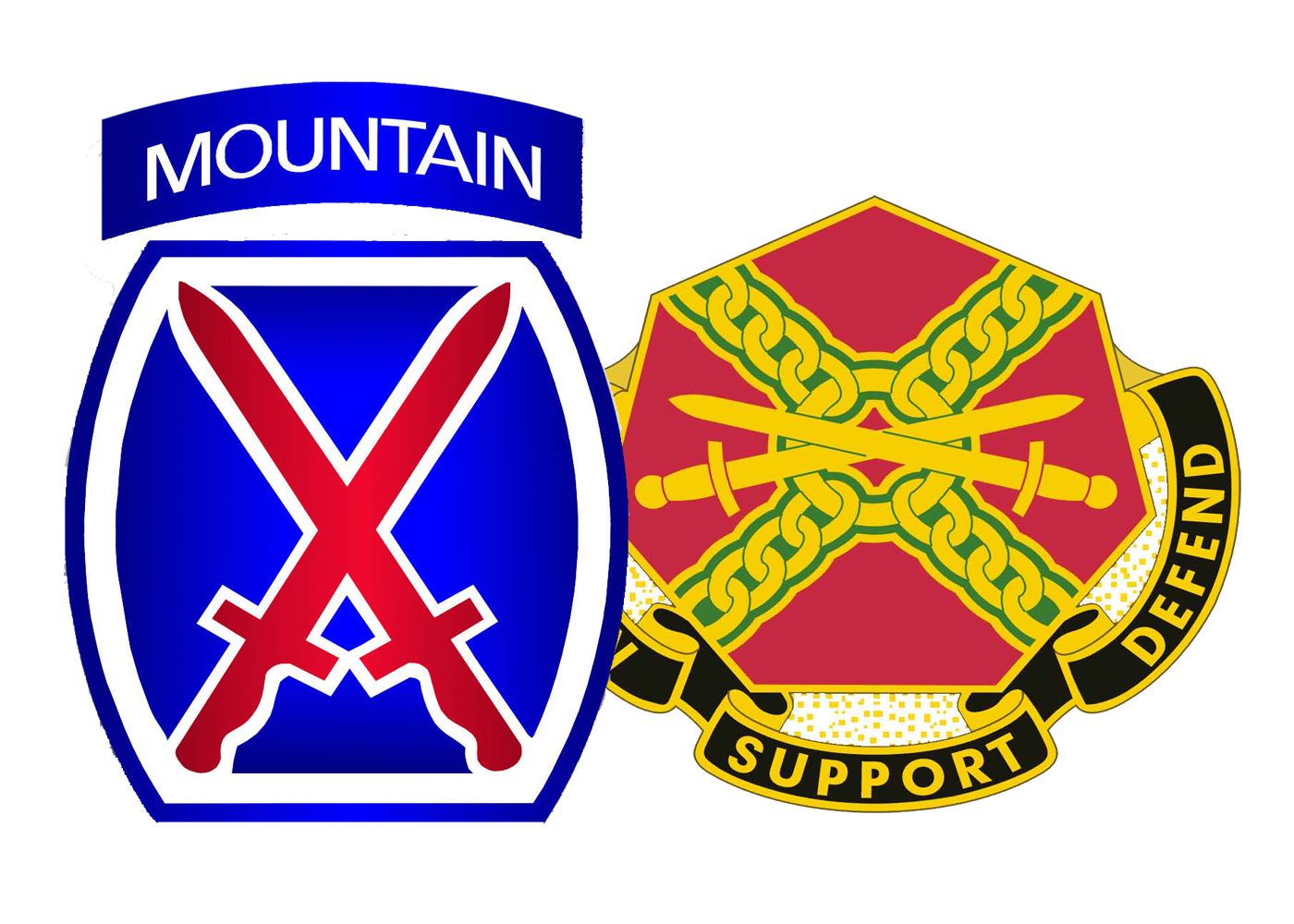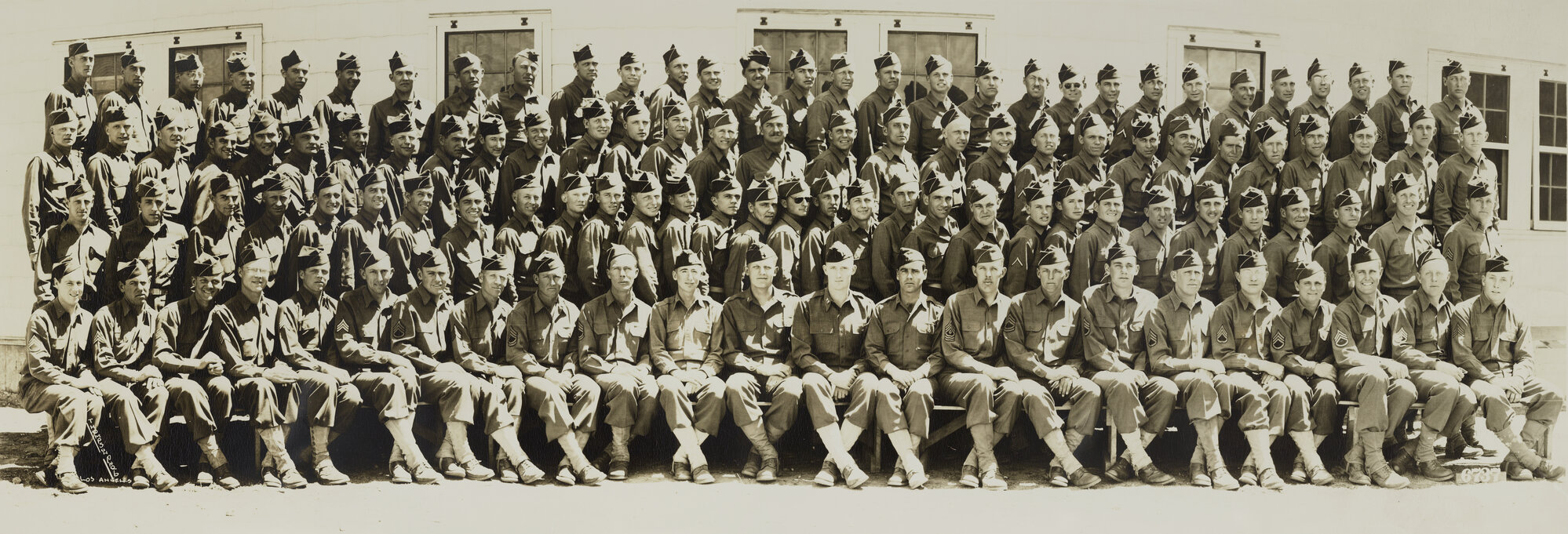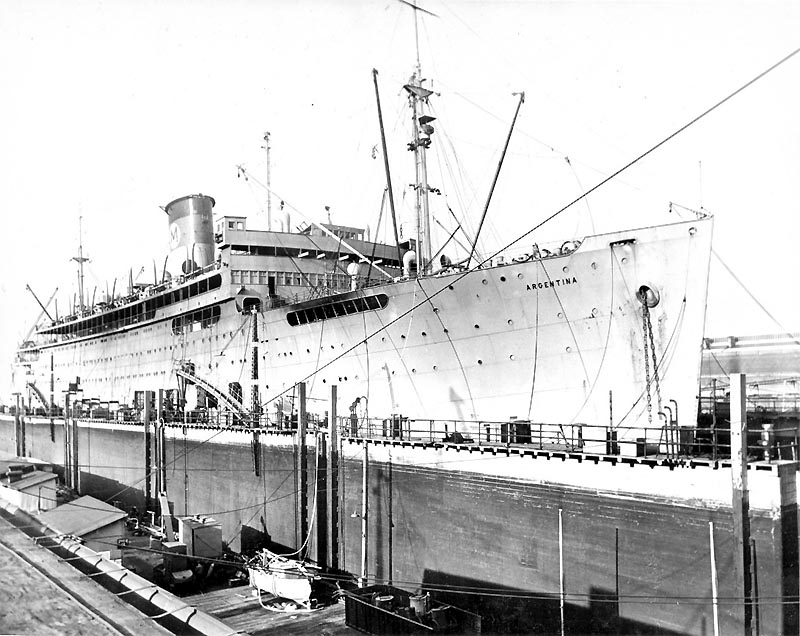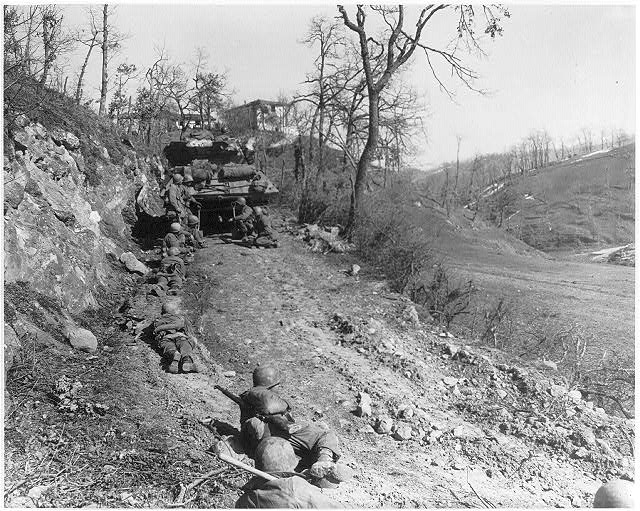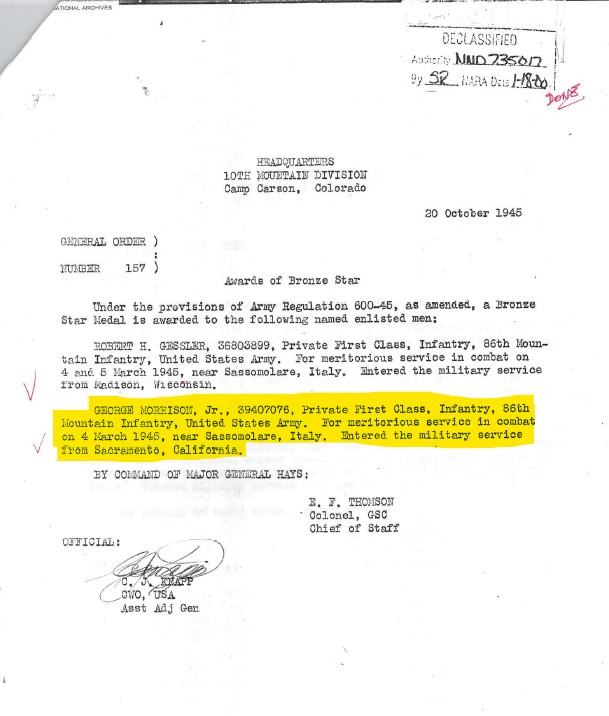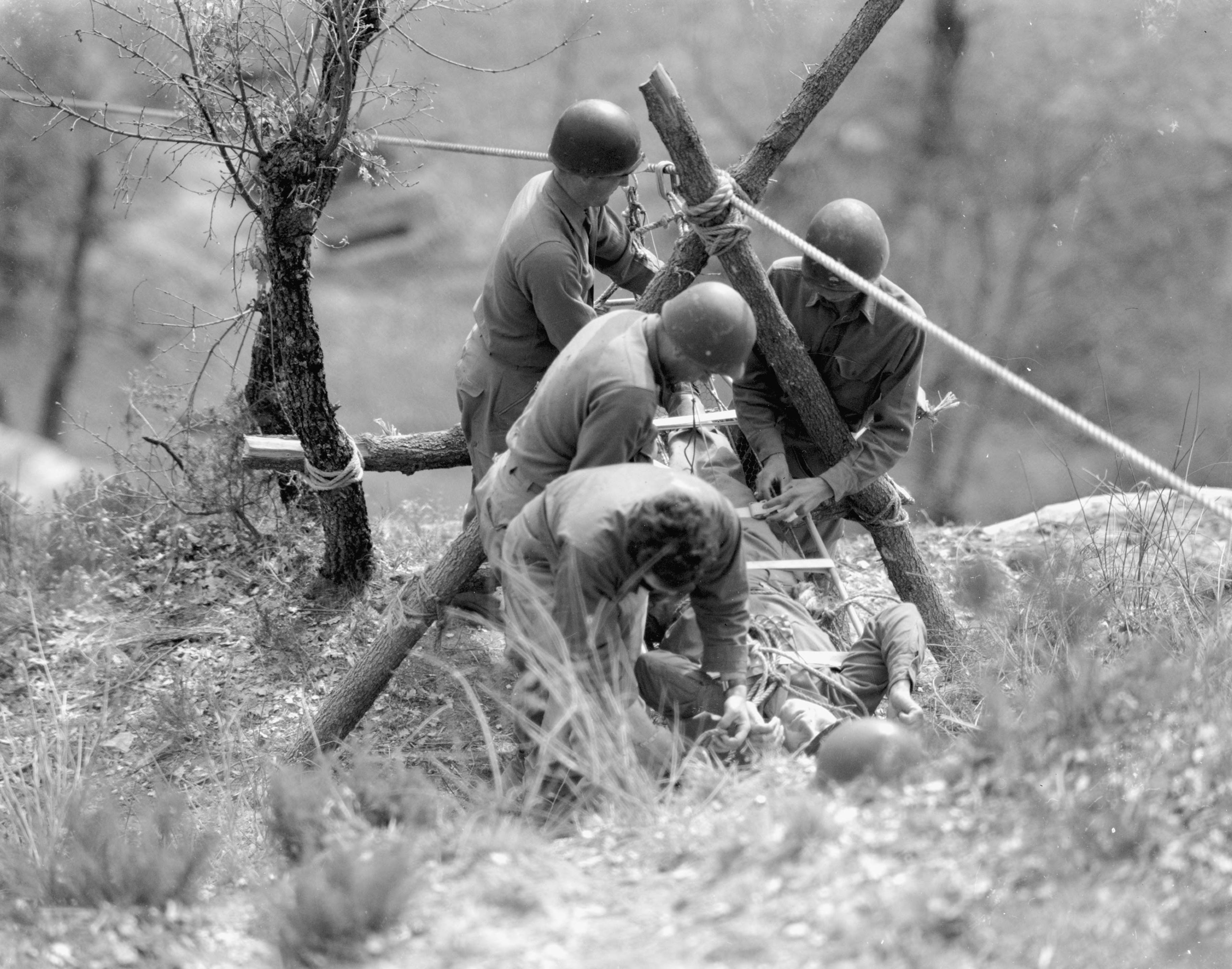86th Infantry Regiment, Company C
Dear Mom + Dad, June 27, 1945
I have a little time this afternoon, so I will write a little of all the things that I have done in the past several months. I had gotten out of the hospital November 23, 1944 and had a week on pass in Austin. I went in Saturday and met a family who gave me a ride in their car and took me to their parents’ house for a meal. They asked me to come for Thanksgiving dinner a week after the nation had it, but Tuesday I was sent back to the company.
I phoned Aunt Alice and you all telling I was leaving Swift. On Wednesday evening we were taken by trucks to the train in Camp Swift. Thursday we went through Oklahoma, then Kansas, Missouri hit Saint Louis at midnight, then Illinois, (cold snow on ground) Indiana we got out for 30 minutes and ran around in the snow. It was very cold, glad to get back in the train. We continued Ohio came into Cincinnati Friday night about 8 PM then on to West Virginia to Camp Patrick Henry.
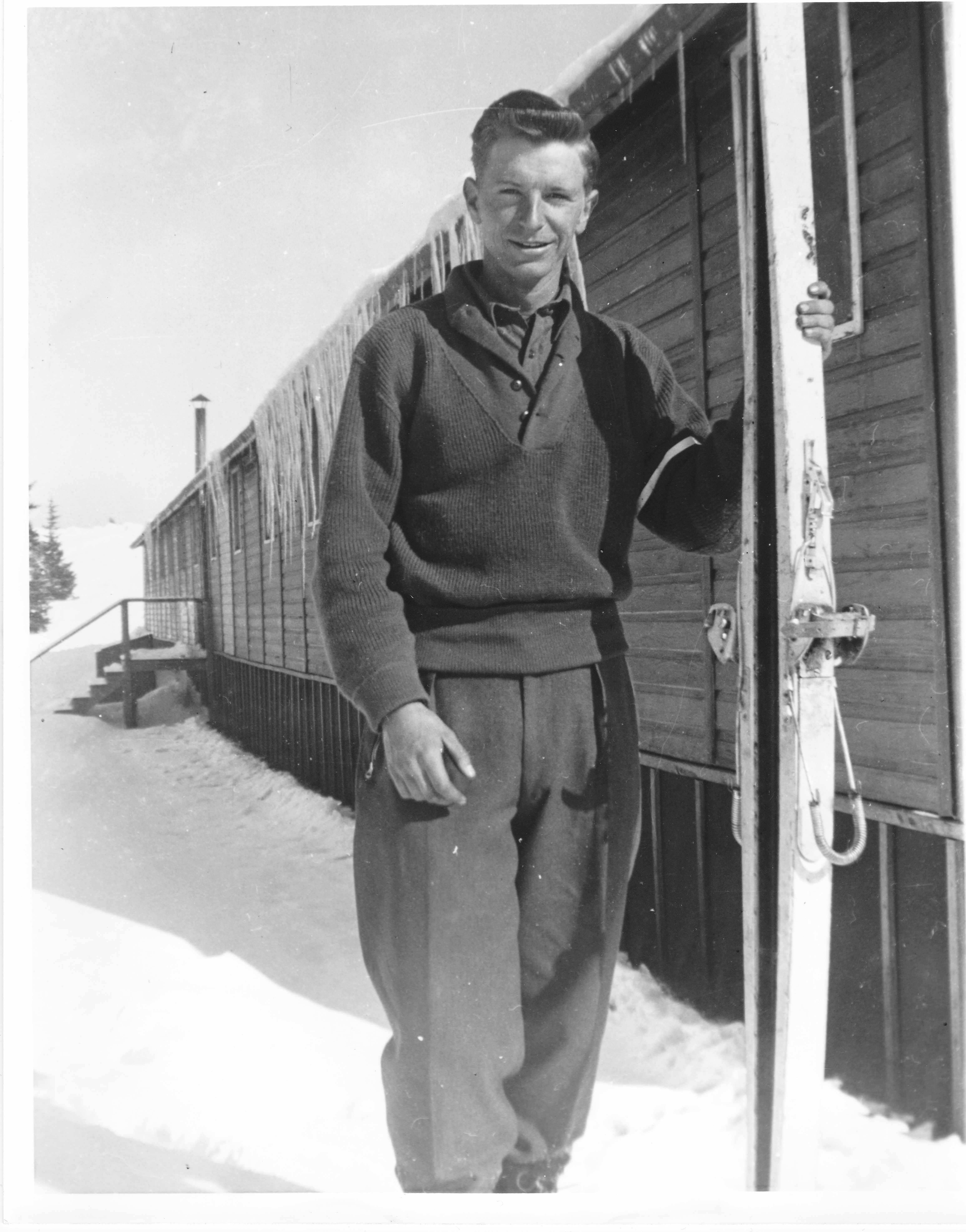
It’s about Newport News, Virginia where we stayed three days. It was cold there and a little damp. I got all new clothes and checked equipment. Phoned you all a couple of times. Then Saturday night at 11 o’clock we walked to the train which rode us 20 miles to the boat at Newport News. I was given a dixie cup of coffee by the Red Cross, (another) and stepped on the gang plank about midnight.
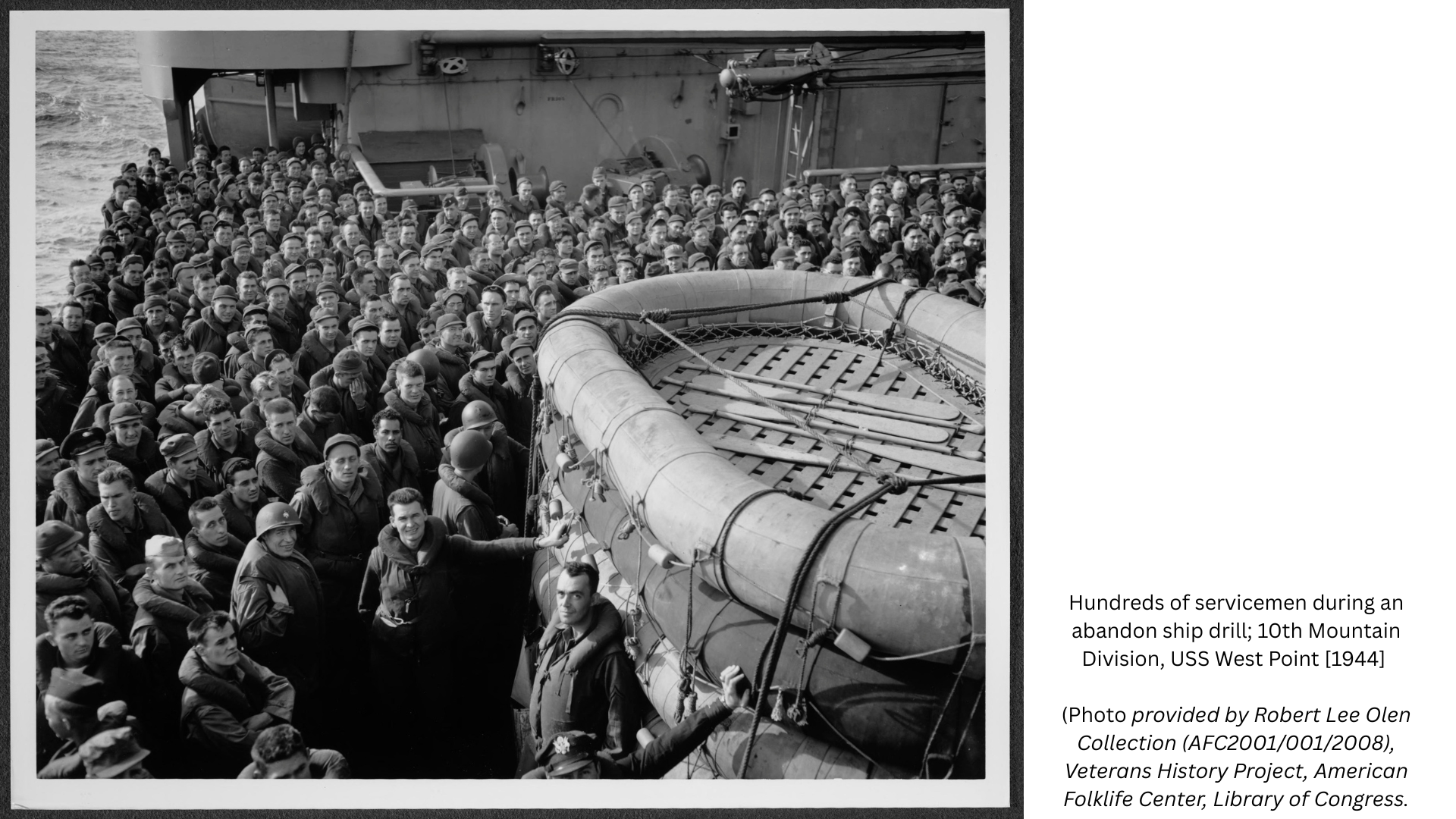
I went down to the D deck, just above the water line. The boat was loaded and started out at 8 AM Sunday December 10, 1944 we met part of a convoy that noon and later at night. I was on a boat called the Argentina. It was an Eastern Boat Lines to South America before the war.
We were really crammed into the holds and I had a fellow sleeping above me and three under. Some were 8 men high, but we managed.
I slept next to Jack a teacher from north Sacramento, teached at Grant Union. We are good friends.
I was free all the time and walked around the deck every day and almost every night. We ate a fair chow and I even got a little sea sick but got over it in a few days. We had had calm weather all of the trip but the waves were a little rough.
The 10th day we sighted land. Africa! We went through the Straits of Gibraltar and I was taking it all in. The weather was bad when we were in the Mediterranean near Algiers. I looked over the funny African countryside. The 13th night, December 22 we pulled into Naples Harbor about 9 o’clock. The weather was cold, windy and damp.
The next morning we were pulled in and I looked over Naples from the boat. You could see the damage which was done by us by air and artillery. We got off the boat December 23 about noon and a Red Cross girl gave me 2 doughnuts, (coffee in the states doughnuts here). We were driven through Naples to a large modern school which use to be the Italian West Point. Of course, it was airy, no windows because for our bombs and cold, no heat. We had C rations in cans and slept on marble floors. I had a lot of blankets. I went to the Red Cross where it was warm, ice cream after sweating out a long line. I wrote you all a couple of V- mails.
I met Lee Gebhart and talked to each other. The most of the day, December 24 I spent at the Red Cross and just sitting and writing. I went there Christmas Eve (night) too. We had to go back to the school and to bed by matches.
December 25, Christmas Day, we had a dinner, and had turkey then got ready to leave at noon. We boarded train in Naples Christmas noon. It was cold and the train was just box cars but about half the size of our box cars at home. We had 25 men per car, it was crammed, but it was cold and everything was o.k. We even opened up the sides so we could look out. The car rode like a bucking horse, but I slept and did ok. I woke up when we passed Cassino, so I saw the rocks and rubble which was once a town. We went up to the outskirts of Rome only a mile away, we continued up to a station about 35 miles from Livorno (or Leghorn) then we got on trucks and rode up to Pisa. We bivouacked outside of Pisa about three miles. I could see the leaning tower.
I had a little pup tent with another fellow and there we got our equipment and stuff that we needed. It was cold there and a heavy frost. We could see snow all over the mountains and hear artillery fire. We were put on the alert because they were having trouble up on the bigger front. They dumped out ammo to us and we got everything we needed. I had to dig my first fox hole in case we were attacked by aircraft. We did have an alarm, but some were just caused by a false thing. We spent three days there then moved back by trucks to below Leghorn about 10 miles. We bivouacked on hills overlooking the sea. I spent New Year’s Eve and a few days there.
Because my knee was not in good shape and they wanted to give it time to heal, they let me guard duffel bags for a couple of weeks near Pisa. About 10 miles outside of Pisa.
I was sent for about February 3 and from there I went up front to San Marcello. We left there in two days to go back to Lucca. We rested in some large estate about 9 miles outside of Lucca until February 16. We packed up and got on trucks for the front. We got off at Vidiciatico and hiked about 12 miles to within yards of the German lines. We had a hard time finding the buildings and I was falling and slipping on the ice and snow but somehow after getting lost, I caught up with a couple of fellows and we made it to an old stone house. The company was in these two houses the few hours of the morning Feb 18 and left at dark for the attack up to Riva Ridge. It was cold and I helped carry signal wire up a ways and keep the line open to the company going up. I went back to the house where I helped with 1st Sgt. Shaffer stay on the phone both day and night. I took the messages to Battalion one night through enemy territory and I had that rifle ready to kill if I saw a shadow move. I had to go through snow over a hill and through deserted villages and with the moonlight every tree made a shadow look like a person and enemy. I got a couple of hours rest then took over the phone.
When I was on I had to call Battalion and report they reached the ridge and made it ok. The next day they had a fire fight. I reported some artillery which came in near us. That night of the 19th of February the weather was cold and I was talking to a Lieutenant friend who was up on the ridge. At 2 AM of the 20th, he went out because of a patrol (Germans) was attacking them again on the right flank. He was killed with about 10 other friends of mine. 3 fellows were captured. I heard a couple of days ago that one fellow who was captured got home.
I helped haul down the wounded. I worked five hours on this one good friend of mine, it took him 15 hours to get down from the top. It was a hell of a trail. I helped give blood plasma. Other friends of mine who was shot through the neck and chest, others the legs, ankles and others had to lose their feet or legs because of the cold and it took so long to get down.
The 21st of February we moved back to a little town and took off for Gaggio Montano. Rested 2 days and the third day took a short truck ride for about five miles outside of Gaggio Montano. (A little artillery came in while we were on the rest and I even slept through our own artillery.) We hiked up to almost the top of a hill and dug in good deep fox holes. I and the 1st Sgt. slept together. We waited 2 days there and pushed off March 3. We attacked for about five miles and then hiked to an area up a ways and dug in. It was midnight. During the night they (the Germans) threw in some artillery close and with the cold weather and artillery I was shaking and freezing. We had C rations the next morning. I helped carry a case to the company, just so I could eat it.
We got ready after eating dog biscuits and went into the march for a ways before the attack. We had a 15 minute or longer artillery barrage on the town while we were walking up. I would keep my eyes on the fighter planes while they strafed the town bombed it with gasoline bombs. The artillery lifted and then we opened up with machine guns of our own. The enemy let the company get almost to the town which was up on a hill and then they opened up with machine guns and mortars. I started to dig in then I moved so much that I forgot about digging in. Their mortars were getting close and I hoped they would be put out. I fired at a German who was directing the mortar fire, but I don't know if I hit him. The tanks came up and that helped out more than anyone will ever know. We started to continue up to the town, even when a German tank opened up on us. Our tanks knocked them out.
Because the company was shot up pretty bad, I went up and helped out with a BAR man in the assault platoon for the next attack up the next mountain. The artillery and mortar fire was coming in thick and heavy. We had an hour rest and it seemed like a life time. We pushed off at 1 PM and then over the top we went. I was running back and forth and forward hitting the ground in defilade and ditches and firing at different German dug outs. We were being fired at but you had to advance.
We were doing ok when we got down in the valley we had to wait until our flank caught up. They were nowhere in sight. We were pinned down while our artillery put in a barrage over our head on to a level spot a few yards over us. I can't explain myself, it is a wonder I am not gray haired now. It lasted for a 1/2 hour, but God must have been with me. The men killed (were) behind me, but anyway we continued and I saw a German and fired at him, others did also. I think he was killed. We reached the top and dug in. That night we took guard post and I watched miles of German land. The next morning a German patrol came up and a man killed the German captain by cutting his head off at the forehead with a BAR.
A friend and I dug in on the forward slope under sniper fire. We sweated out from March 5 till 16th then we had to walk back through Purple Heart Valley to where we got trucks went to Montecatini on a battalion rest. My nerves were shot because of all the artillery and mortar fire at us those 14 days. I saw three movies and had a couple of cups of coffee and cookies at the Red Cross.
I went back on line the 20th of March and stayed 2 weeks. We had three more days rest then back to the front. We waited around there until April 15 and you should have seen the tanks, halftracks, artillery and everything. It looked like a great circus. The push off came in the morning after about 45 minutes of artillery bombing and all fires possible.
It was hard the first day, the mines fields hurt and killed a lot of fellows, but the push went on. The first night they went a good ways and the second day they were looking over the Po Valley. Spent next day in Po and artillery fire was coming in.
April 23, at San Benedetto, crossed the Po river. We had been drinking champagne and wine till everyone was almost drunk.
The attack went on, fast and couldn't stop us. It did take about six days to reach the mountain overlooking the Po Valley though. We crossed the river. I went up to Bussolengo, spent the night in a town and had some more wine, ate bread and a couple of fried eggs. We went up to Lake Garda and the 86th had a hard time going up to the north part of the lake. The Germans had everything ready. I went up to the end of the lake in a duck and brought up the mail I had. We stayed there and didn't attack and a day or two later we found out the war was over. It rained a lot and it was cold and damp. Were afraid to build fires or have lights for fear the Germans would shell us, but I guess the war was over for us here in Italy. I was so glad that I went in bed and didn't worry much about artillery fire. Fellows fired their rifles and pistols, but I just went to bed, May 2, 1945.
The rest of the war ended May 7 and 8 and during my time up on Lake Garda, I went swimming and over to this little town across the lake. I slept at a little hotel and we bought some fish from a fisherman and had them prepared by the little hotel family. We had wine and sat out on the porch looking over the lake, which was a beautiful sight like Lake Tahoe.
We moved back by truck to Brescia, and bivouacked on an Italian airfield for a few days. It was hot there and I went in one night to Brescia and looked over the town with a fellow from Sacramento called Bino Grifantini. We had some wine then back to bed at 10 o’clock.

I went the next night down to where the German Armies were going into the PW cage. We heard the papers say Tito wanted Trieste and they didn't want him to have it.
We were sent up to make sure the mountains and roads were kept open up here at the Austrian, Yugoslavian border.
We are here resting, rock climbing and going on passes. I hope to go on one to Trieste shortly. I will write about it.
We are waiting to see what is in the future, but I am resting and taking life easy. I will close for now and write any news later.
Always love,
Brother
THE STORY BEHIND THE LETTER
Mike's article
TIMELINE OF 86TH MOUNTAIN INFANTRY
86th Mountain Infantry in Italy, Charles Wellborn 86th Headquarter Company 1945.
Thursday, November 23, 1944 – Morrison is released from the hospital. GEN Hays arrives at Camp Swift.
Thursday, November 23, 1944 – Monday, November 27, 1944 – On pass in Austin but is called back early.
Tuesday, November 28, 1944 – Morrison tells his family they will deploy very soon.
Wednesday, November 29, 1944 – The 86th left by trucks in the evening to board the train at Camp Swift. It had been a fast, unexpected movement. Jerked from a scarcely begun maneuver, the men of the 86th had boarded trains at Camp Swift, Texas, and sped across the eastern United States to Camp Patrick Henry, Virginia. There they had just had time enough to give equipment a lastminute check and make those all-important phone calls home.
Thursday, November 30, 1944 – The journey begins by train to Camp Patrick Henry.
Saturday, December 9, 1944 @ 2300 – Troops walked to a train that took them about 20 miles to Newport News, VA.
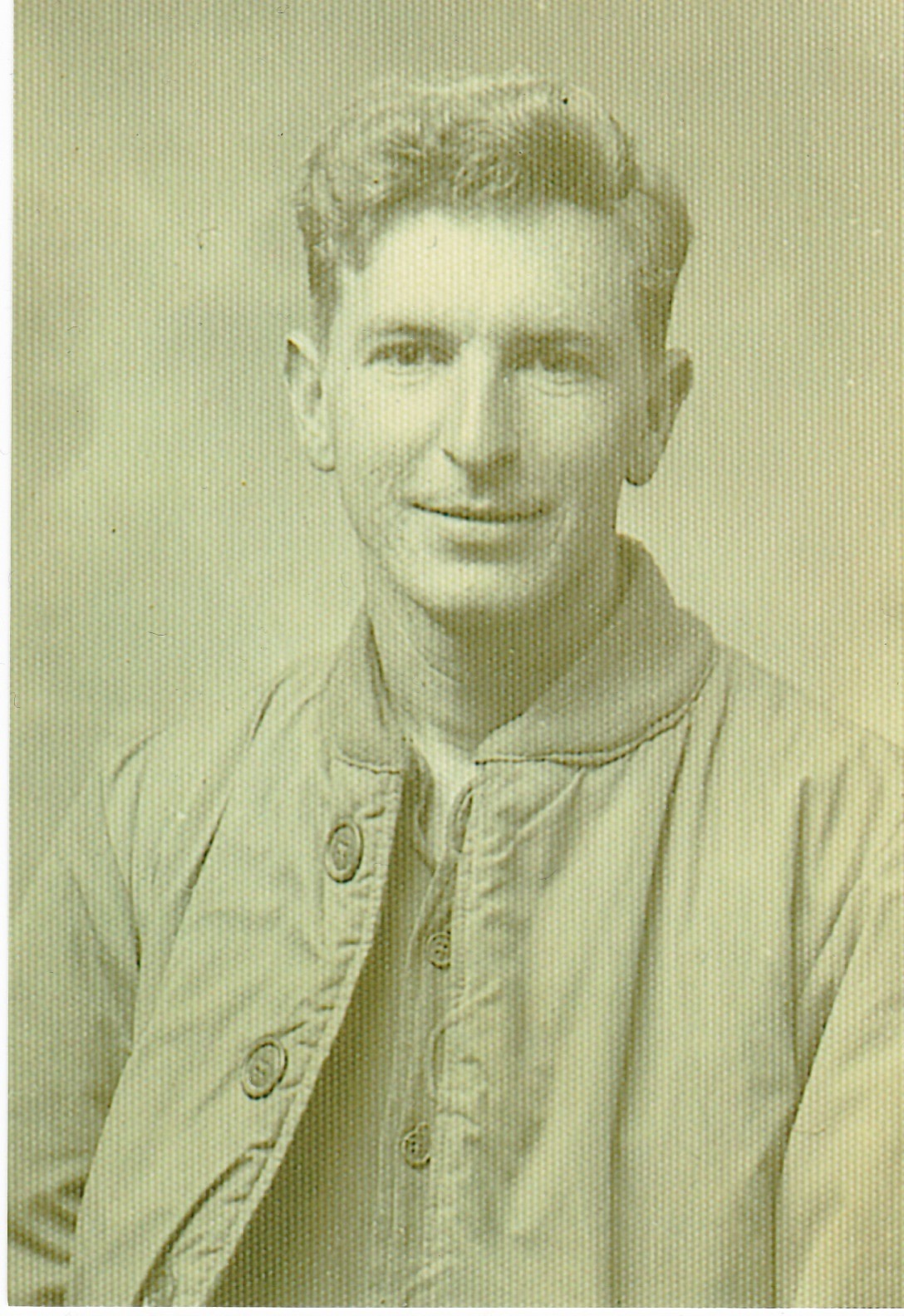
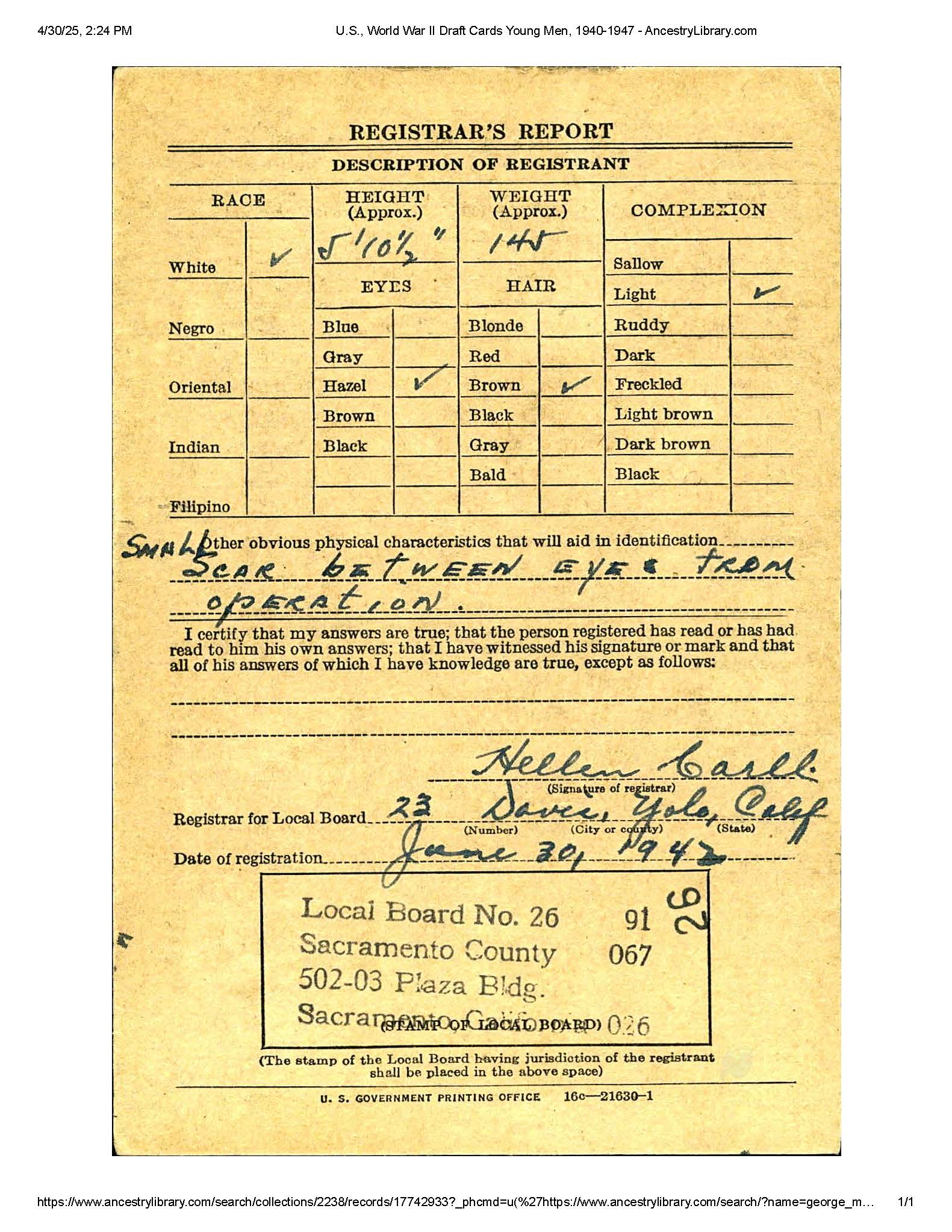
Sunday, December 10, 1944 @ 0000 – The 86th boarded the SS Argentina. No one had much time to think that morning. It was the 10th of December 1944, and a cold breeze swept across Hampton Roads. Every man was busy with his equipment. It was a (big) job to handle the overloaded pack and duffle bag that each man carried, to say nothing of the rifle, gas mask, and steel helmet. Somehow they managed to make it past the checker and up the slanting plank to the deck of the SS Argentina, a former luxury liner on the Caribbean run. Eventually each man found himself in a bunk and began to shed his equipment.
Sunday, December 10, 1944 @ 0800 – The 86th left port in the SS Argentina.
Sunday, December 10, 1944 – Friday, December 22, 1944 @ 2100 – The 86th journeys across the Atlantic. All in all, there was quite a bit to occupy a fellow who really wanted to find entertainment. The first few days there was the newness of ocean travel—and probably a bit of seasickness. After that, there was a varied recreational program… movies on deck, or if you didn’t care for that, boxing bouts on promenade deck aft. On board were two USO units, and every night in the big troop mess, they performed for capacity houses. Every day, from noon until 2000 hours (8pm), the ship’s radio station, WARG, gave out with music, news and variety programs. When there was nothing else to do, men read, played endless hours of poker, or walked the deck, watching the waves or the other ships in the convoy.
Friday, December 22, 1944 – The Argentina dropped anchor near the port at Naples (arrived the 13th night)
Saturday, December 23, 1944 – The Argentina is pulled into port. Next morning, the mountain troops saw their first signs of war, as they gazed at rusty hulks of once-great ships that filled the harbor. They saw more of war’s after-effects as they were whisked through the oft-bombed streets of Naples to their first stop, the half-completed buildings of an orphanage in Bagnoli, a suburb of the great city. Bagnoli was a staging area, and the regiment was not to remain there long, for which most of the men were grateful. The marble floors they slept on were cold, and the rations were infinitesimal.
Saturday, December 23, 1944 – Sunday, December 24, 1944 – Morrison spends most of his time at the Red Cross.

Monday/Christmas, December 25, 1944 – 1st Battalion leaves with advance party by train at noon. December 25, Christmas Day, we had a dinner, and had turkey then got ready to leave at noon. We boarded train in Naples Christmas noon. It was cold and the train was just box cars but about half the size of our box cars at home. We had 25 men per car, it was crammed, but it was cold and everything was o.k. We even opened up the sides so we could look out. The car rode like a bucking horse, but I slept and did ok. I woke up when we passed Cassino, so I saw the rocks and rubble which was once a town. We went up to the outskirts of Rome only a mile away, we continued up to a station about 35 miles from Livorno (or Leghorn) then we got on trucks and rode up to Pisa. Two days after the landing, on Christmas day, the First Battalion and Headquarters. Company, minus the I & R [Intelligence & Reconnaissance] Platoon, left by train to serve as an advance party in a newly assigned area. The movement was delayed by a train wreck and had to be completed by truck.
Wednesday, December 27, 1944 – Sunday, December 31, 1944 – 1st Battalion bivouacked in staging area near Pisa, the Battle of Garfagnana was raging not far away.
Sunday, December 31, 1944 – 1st Battalion moved to bivouac in Quercianella. At 1600 on the last day of the year, the regiment moved out in truck convoy for its new bivouac area at Quercianella, just south of Leghorn on the coast.
Sunday, January 7, 1945 – 86th is on its way to the front, Morrison stays back due to knee injury. The advance party moved out of Quercianella January 7. They contacted Task Force 45, under whose control the 86th was to operate, and also the units to be relieved. On the 8th, the rest of the regiment began its departure from the bivouac area. By 1830 that night the three battalions were in their initial positions: the 1st Battalion in the vicinity of Castelluccio, the 2nd near San Marcello, and the 3rd in Bagni di Lucca. The 1st Battalion completed the relief of units of Task Force 45 at 0706 the next morning. At 1300 the regimental CP [Command Post] was opened in San Marcello. By nightfall, communication was set up, and the 86th had begun to function as a combat unit, holding its sector of the line.
Monday, January 8, 1945 – Friday - February 2, 1945 – 1st Battalion stayed on the front line, and it was generally quiet.
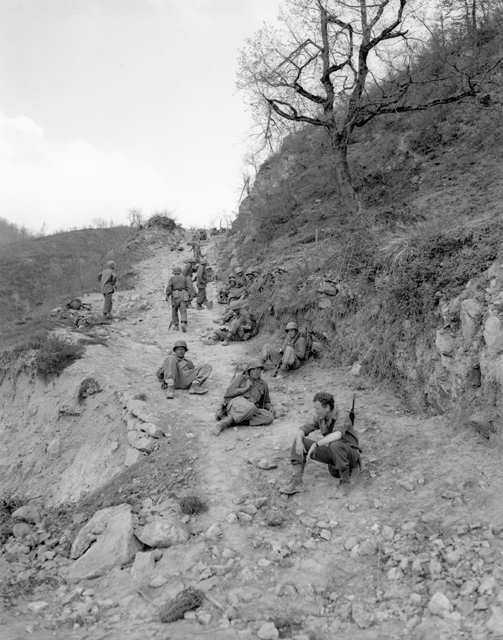
Saturday, February 3, 1945 – Morrison is called to the front, joins 1st Battalion in San Marcello and then moves with the 86th Regiment to Lucca. On February 2, the 86th was relieved by elements of the 87th and 85th regiments and reverted to Corps reserve. The troops were withdrawn to a training area in the vicinity of Lucca, and a CP was opened in a beautiful villa in the little hamlet of San Cassiano di Moriano. As the regiment rested and trained in its rear area near the old walled city of Lucca, there was a suspenseful and somewhat grim expectation in the air.
Wednesday, February 14, 1945 – Saturday, 17 February 17, 1945 – Regiment leaves by truck to the vicinity of Castelluccio, then marching toward the base of Pizo di Campiano (Riva Ridge.) The 1st and 2nd Battalions detrucked in the vicinity of Castelluccio and moved out immediately. By midnight the long lines of trudging soldiers in the 1st Battalion had cleared Vidiciatico. Above their heads, piercing the pitch-black darkness like long fingers of molten steel were the powerful searchlights playing relentlessly on the slopes of Belvedere and Campiano. Between the columns of men rolled a steady column of jeeps and trucks, as supplies, ammunition and equipment moved up.
Saturday, February 17, 1945 – 1st Battalion rests, and prepares to take the Ridge.
Sunday, February 18, 1945 (Daytime ) – 1st Battalion sets up CP at Farne, 1st Battalion readies for the attack which is to start that night. The 18th of February was a busy day, for officers and men alike. To maintain the element of surprise, men must stay under cover, but there was plenty to keep them occupied. Weapons were checked and double-checked, ammunition issued, equipment inspected. By now, every man knew “this was it.”…elaborate arrangements (were made) to ensure that the CP could keep in touch with everything that went on during the action. …positive information (was to be) reported as it occurred. Negative reports were to be made every half-hour. Methods of PW evacuation had been worked out, and in order to secure more information on the spot about enemy action, Division (was asked) for a prisoner interrogator. An IPW team of two men was immediately attached to the regiment.
Monday, February 19, 1945 - Company C takes their target - Mt. Serrasiccia. At 0505 Company C, which had the longest and hardest climb, finally settled down on Mt. Serrasiccia. The objectives were reached—with little fighting and with almost complete surprise. A few Grenades tossed into earthen pillboxes, a few pasty-faced trembling German prisoners, and the ridge that “couldn’t be taken” was ours. Now the problem was to keep it. …(by the early afternoon) Company C on Mt. Serrasiccia was fighting off a 40-man German counterattack. Forced to pull back off the crest, they called for artillery support, and the resulting barrage, including 83-mm and 60-mm mortar fire, temporarily broke up the attack. …A large group of Germans came out of cover with hands raised high as if in surrender. …(the) company held their fire and the Germans drew close to their positions. At the bottom of the little ridge on which Company C was dug in, the Germans suddenly fell to the ground, brought out their weapons, and opened fire. Company C had not been fooled, and the Germans gained nothing but numerous casualties from the trick. All day on the 20th, the 1st Battalion repulsed German attacks. Twenty-six dead piled up in front of one B Company position. Seven prisoners were taken, six of them mountain troopers. The evacuation of casualties from the Company B positions on Cappel Buso was especially difficult. Some litter cases took as long as 20 hours, but the litter bearers … worked night and day to get the wounded back to the collecting stations.
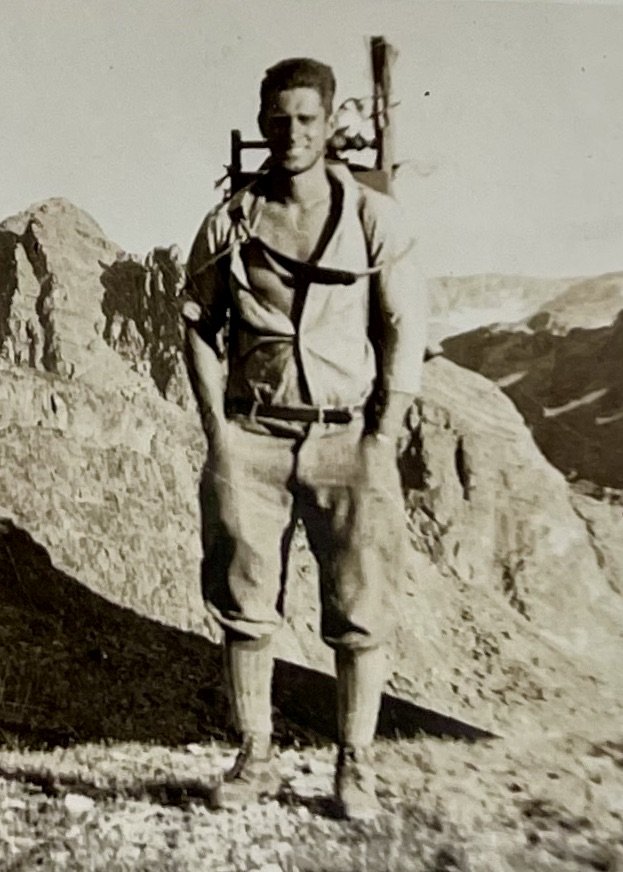
Tuesday, February 20, 1945 – On Mt Serrasiccia the fight continues, Morrison helps bring down the wounded on the tramway, in the early morning hours of Feb 20, LT John McCown is killed.
On Mt. Serrasiccia, Company C battled furiously. The artillery dropped 84 rounds on the enemy in that area with telling effect. Air support aided too, as planes swept down to bomb enemy installations not a hundred yards from the American lines, especially in the Rocca Corneta area. At 1300 on the afternoon of the 20th, Company C jumped off in a new attack along the Serrasiccia ridge. Despite the strong enemy resistance, partly shattered by a 15-minute artillery barrage including effectively timed fire, …(the company) gained (its) objective in 28 minutes, killing 4 enemy and forcing the remainder of the German force to withdraw.
Excerpt from Blizzard – (Italy 27 February 1945) “It cannot be understated the significance that the 126th Engineer Mountain Battalion had in the battle for Riva Ridge. Casualty evacuations were difficult on all fronts of the war, but even more so in the mountains where enemy fire, mortars and terrain combined for a constant threat of danger. Thanks to the
skillful ingenuity of Company D, 126th Engineer Mountain Battalion, wounded men were
transported to safety from an almost inaccessible mountaintop by cable tramway.
Constructing an aerial tramway up the ridgeline was an unprecedent accomplishment in
U.S. military history and undoubtedly saved many lives because it cut casualty evacuations from three to five hours down to several minutes.” At 1855 the first estimate of casualties was reported to Division G-1. In the light of what had been accomplished, it was amazingly light, though nonetheless serious. Killed: 1 officer, 6 enlisted men; wounded: 2 officers, 25 enlisted men. The officer killed was 1st Lt. JOHN MCCOWN of Company C, a veteran mountain climber whose rambling bow-legged gait and contempt for army red tape had made him a well-known figure to almost every man in the regiment. He had been riddled by a German machine gun as he made a reconnaissance patrol.
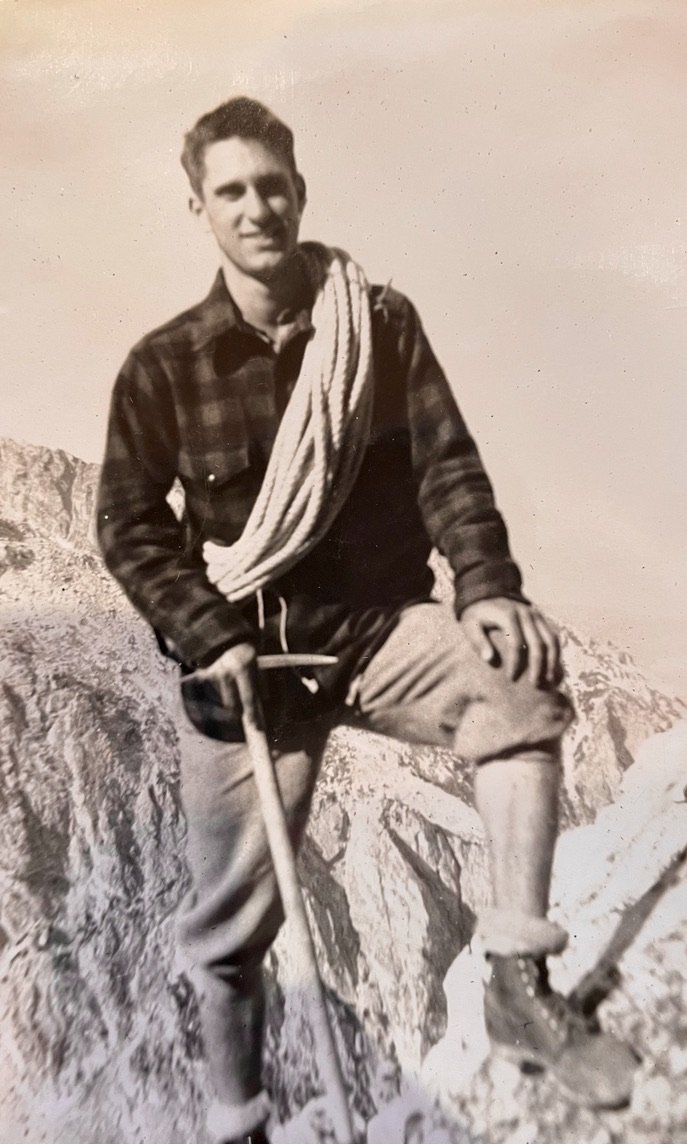
Wednesday, February 21, 1945 – 1st Battalion is on the move again. The 21st of February we moved back to a little town and took off for Gaggio Montano. Rested 2 days and the third day took a short truck ride for about five miles outside of Gaggio Montano. By 1700 the 10th Reconnaissance Troop and the 10th Anti-tank Battalion were beginning to relieve the 1st Battalion. …the regiment was in the process of moving to Gaggio Montano where the new CP was to be set up. Up there on the ridge they had left their buddies, men they had lived with and worked with, many of them almost two years. They were bitter and mad, but they were also very, very tired. Some had not slept or eaten for more than three days. Many were heroes, recommended for combat decorations. Despite their bitterness and their weariness, they were proud of each other and proud of themselves.
Friday, February 23, 1945 – Gaggio Montano comes under fire. Evidently the Germans were suspicious of Gaggio Montano for at 1549 (3:49pm) the first of several artillery shells fell within 50 yards of the CP building. At 1740 (5:40pm) the CP and aid station were shelled again. Two casualties resulted, and even the most dignified of the regimental staff assumed the prone position, especially after one shell hit the corner of the building. At 1825 (6:25pm) the town was shelled a third time, and everyone agreed that the (Germans) knew entirely too much about the movement to Gaggio Montano.
Saturday, March 3, 1945 – Just after dawn the next push begins, with 1st Battalion to take the high ground east of Monteforte and Hill 928 – Objective Able. Company C… the advance was speedy but by no means simple. The Germans poured artillery, mortar, and machine gun fire onto the attackers. But the first phase of combat operations had taught the 86th a vital lesson: never let the Germans pin you down. Keep moving. Once pinned down, you are an easy target for (German) artillery. Despite a hail of fire, the companies moved up. At 1052 the final objective, Hill 928, was reached by Company A. Objective Able was conquered. For the 1st Battalion the first phase was over.
Sunday, March 4, 1945 – 1st Battalion fights toward Sassomolare/Morrison Earns the Bronze Star. Next morning at 0745, a new artillery barrage opened up, and at 0800 the 1st Battalion was off again, this time toward Sassomolare. At 0839... Companies B and C were attacking on line. At 0910 the advance was held up just south of Hills 892 and 859 by small arms and automatic weapons fire… By 0950 the battalion was once more moving ahead… At 1109 Sassomolare was completely ours. (Next was)… a coordinated attack on the next objective, Mt. Grande. Company B was to attack on the right, Company C on the left, with Company A following C. Company D was to support from the high ground at Sassomolare. The attack was to jump off following a 27-minute artillery preparation. The attack was delayed by more harassing fire from the right flank. At 1315, 12 minutes ahead of schedule and while friendly artillery still fired, the battalion jumped off. Despite these initial handicaps, the advance proceeded. The artillery continued to pour heavy fire on targets of opportunity, and Rover Joe strafed the reverse slope of the objective. By 1400 Company C was advancing up the slope of Mt. Grande. At 1525 the objective was taken. Pfc. CHARLES LE WECK of Company C explained the method of capturing prisoners. With Mt. Grande taken, the advance was virtually over. The 86th had accomplished its mission. Opposition had been stiff. From 1st Sgt. DOUGLAS TRAIL of Company D came a concise summary: “These last two days have been a bunch of hell.” Division G-2 warned… the enemy was capable of counterattacking with a strength of two battalions. Another sleepless night loomed for the men on the line.
Monday, March 5 – Friday, March 16, 1945 – Enduring constant danger and intense stress, the 1st Battalion Holds the Line. March 5…in the 1st Battalion area, Company C had found isolated pockets of enemy resistance on Hill 954. They spent the morning cleaning out the area. Position consolidation continued, though the men were constantly harassed by enemy artillery. Supplies were largely carried by mules. In the early morning hours of March 6, it appeared at last that the Germans were preparing to attack. …Sirens could be heard, and between 0400 (4am) and 0500 (5am) a small-scale firefight broke out in the 1st Battalion area. The Americans were quick to retaliate. … to the intense relief of all concerned, the German attack did not materialize. At noon that same day …The Rover Joe planes were out again, strafing possible enemy positions. Up on the ridge and down another the planes went, beating the ground with their machine gun fire. On the ridge running down from Mt. Grande, the 1st Battalion men sat on the edge of their foxholes and cheered the planes as they did their deadly work. Suddenly one plane headed directly for the 1st Battalion positions and dived low, continuing its fire. The men below sat stunned for a moment and then leaped for cover. Some didn’t make it. The pilot, confused by the sight of similar ridges below him, had misjudged his terrain. One officer and nine men were wounded on March 7. Early on the morning of March 8, an intelligence crew from the 1st Battalion, digging in an OP, ran into heavy and accurate machine gun fire. Intermittent machine gun fire swept the entire 1st Battalion front almost every night. And.. the artillery continued to fall, killing one man here and wounding another there. The men in the foxholes sweating it out, seeing each dawn with the relieved realization that another night had passed without a shell in their particular dugout. On March 11 … the 1st Battalion motor pool was heavily shelled, wounding one man. General DUFF inspected the forward areas, but more important to the men was the fact that 10-in-1 rations, with their added variety, were substituted for the tiresome C-rations. Company C, on Sasso Baldino, beat off an enemy combat patrol on March 12, but was constantly forced to contend with enemy snipers who infiltrated behind the lines and fired on positions from the rear. …Company C was fast finding that every house was heavily booby-trapped… On the night of March 15-16, the 1st Battalion left the line… (and) moved far back to the division rest area at Montecatini.
Saturday, March 17 – Sunday, March 18, 1945 – 1st Battalion enjoys a weekend away from the front. Montecatini was the nearest thing to a line soldier’s dream—a wide-open town where the MPs were tolerant, the champagne and cherry brandy flowed like water, and there were ample facilities for amusement. Not the least of the attractions was the Club Trianon, a rowdy nightclub with a hot swing orchestra and a shady burlesque show. The men crowded into the movies and bars, met Montecatini’s pretty girls, took a look at its famous marble mineral baths, and generally tried to forget all about the war.
Monday, March 19 – (around) Monday - April 2, 1945 – 1st Battalion is back on the front lines. On March 19 the 1st Battalion left Montecatini… Troop rotation continued on March 20 when the 1st Battalion moved back onto the line (at Il Monte). As March drew to a close, the 1st Battalion was relieved by the 2nd Battalion 87th…(and) moved to a training area… at Piastre, 8 kilometers southeast of San Marcello.
Friday, April 6, 1945 – 1st Battalion moves to Riola. By April 6 it was evident that something big was in the wind. The shifting of sectors, which forecasted the beginning of an operation, started as the 1st Battalion moved forward from its division reserve area to relieve the 10th Mountain Anti-tank Battalion at Riola. This move presaged the shift of the entire regiment into that area. A glance at the map reveals the importance of this terrain. It encompasses the high ground to the left of and controlling Highway 64, the principal route from the south into Bologna. Before any viable force could move up that highway, this rugged mountainous ground would have to be occupied by friendly forces. It soon developed that this was the primary mission of the 10th Mountain Division in the “Big Push.”
Saturday, April 14, 1945 – The push to Po Valley begins. Only one battalion of the regiment was scheduled to be committed on the first day of the attack. The other two battalions were to remain in reserve until the first phase had been completed. “H-Hour” was to be at 0945 (April 14.) The artillery preparation at 0910 would follow the air bombardment beginning at 0830. Promptly at 0830 the airplanes began to circle lazily over the front lines, to be greeted with shouts and waves from the troops below. The planes moved over the valley and let loose with firebombs over Rocca di Roffeno. Great geysers of flame and heavy black smoke rose up to 200 feet in the air, and the concussion could be felt 3000 yards away. When the planes had finished, the artillery opened up, seemingly pounding every spot that the Air Corps had missed. In a few moments the valley was almost completely obscured by a fog of gray, black, and white smoke. The bursting shells started rockslides on the shale slopes of Rocca di Roffeno, and buildings were reduced to irregular piles of rubble. The infantry attack jumped off on time, and at 0951 April 14 the 2nd Battalion (of the 86th) was in position to follow the 87th across the line of departure. As the infantry units advanced, the engineers moved in behind them to build roads and bridges so that tanks and armor could be moved up. The enemy raked every approach route with his artillery, hampering the work of the engineers and impeding supply. Mule trains labored up the steep slopes. When shelling fell close to the road, the mulemen hit the ground, holding fast to the lead rope while the mules stood placidly. At 1622 the Corps commander… ordered the 2nd Battalion to contact the 87th so as to tie up the defense for the night. The 2nd Battalion had suffered damaging casualties in the day’s action.
Sunday, April 15, 1945 – 1st Battalion joins the fight. Next morning, April 15, the preliminary artillery barrage began at 0635. The 1st and 3rd Battalions, in reserve all day, were ordered forward. The 1st Battalion moved into an assembly area just south of Mt. Sette Croci. The night was a busy one, for the commander sensed that they were beginning to crack the German defense. The principal obstacle to a new advance was a heavily mined field just past the proposed line of departure.
Monday, April 16, 1945 – From Po Valley to Lake Garda, the 10th drives on. The mine belt delayed operations considerably. At 0800 on the morning of April 16, General HAYS ordered the regiment to attack as soon as possible, since the 87th had surprised elements of the 94th Division and was now on that unit’s flank. The 1st Battalion had made rapid advances... Company A had reached its final objective, la Predosa, at 2030, having taken 26 prisoners. Company C advanced two and a half miles without casualty, captured 5 prisoners, and occupied its objective at Coste.
Tuesday, April 17, 1945 - The 1st Battalion pushed on to la Palazzina, then to the high ground. The attack was gaining momentum now. Every day brought the troops closer to the long sought- after Po Valley. Already the peaks were a little less rugged. But hard fighting remained before the Germans were to be pushed out of the Apennines.’
Wednesday, April 19, 1945 – In order to furnish a mobile reserve for the division, the 1st Battalion was mechanized with Quartermaster trucks. The mules, having outlived their usefulness, were sent to the rear. The entire regiment was rested as much as possible to prepare for an all-out push into the Po Valley... Many of the men got little rest however, as the Germans continued to rain mortar and artillery fire on the rear areas. By 1500 on the afternoon of April 19, the forward regiments had broken up the enemy resistance, and the 86th received its orders for the next phase. … The direction of attack was northwest, and its ultimate aim was to break into the Po Valley and cut Highway 9, one of the main supply routes from the north to Bologna. At 1800 the regiment began to move forward. The situation was extremely fluid, for the whole front was breaking up. The road was crowded with vehicles and marching soldiers, and the white dust filled the air so thickly that at times it was difficult to see. ..at 2100 (9pm), the battalions were ordered into bivouac areas for the night: the 1st Battalion in the vicinity of Rosario.
Thursday, April 20, 1945 – The 1st Battalion moved into the valley at noon... The advance was going like wildfire. Strong armored support moved with them. At 1500 (3pm) the 1st Battalion cut Highway 9, severing the main supply route to Bologna and dooming that outflanked city.
The magnitude of the breakthrough was difficult to comprehend. The enemy line had been wrecked. After the first stages of the attack there had been little opposition. The 1st Battalion had advanced 13 miles in 5 hours. The Italians in the Po Valley were for the most part completely and deliriously happy. It was a day most men in the 86th would never forget. The race had just begun. The 1st and 3rd Battalions were to move abreast and seize the bridge at Bomporto north of Modena.
Friday, April 21, 1945 – The battalions began to move out at approximately 1100 on the morning of the 21st.
Saturday, April 22, 1945 – As the long convoys wound their way through the Italian countryside, some of them were bound to run into trouble. So rapid was the sweep that formidable bodies of enemy troops were still operating in the rear areas. At 1950 (7:50pm) on the night of April 22, the 1st Battalion encountered fierce enemy resistance at the crossroads. The Germans allowed much of the convoy to pass, then attacked with bazookas and machine guns just as the rear of the battalion pulled past them, scattering the convoy. Two enemy tanks then rolled forward and fired on the convoy, destroying jeeps and trucks. Some fifteen Germans were killed in the firefight, which lasted over four hours. The battalions once again settled down into bivouac: the 1st at Varagna.
Sunday, April 23, 1945 – The advance was continued on the 23rd of April without incident. By noon the entire regiment had reached San Benedetto on the Po River. The battalions remained in readiness to cross the river on a two-hour notice. In the brief interval caused by the stop in San Benedetto, the regiment received replacements and the men rested. In spite of the bright moonlight, enemy planes strafed and bombed the bivouac areas. The rest was short-lived. At 1900 (7pm) the 10th Anti-tank Battalion relieved the 86th in its defensive positions and the regiment prepared to cross the river. The 3rd Battalion was across at 0630 (6:30am); the 2nd at 0830 (8:30am); and the 1st by 1000 (10am). The crossings were made Apr 23 in assault boats and DUKWs and were largely without incident.
Monday, April 24, 1945 – … the regiment set up defense areas in the vicinity of Governolo. By 1105 (11:05am) on April 24, the regiment had received its new assignment from the divisional commander. The 86th was to spearhead the drive toward the historic old city of Verona. Capture of the town would cut one of the major escape routes of the German troops still in northwestern Italy. Attacking at dawn on the 25th, the regiment was to advance in a mechanized column along the main highways north, bypassing airfields at Mantova and Villafranca. Supported by the 13th Tank Battalion, the 701st Tank Destroyer Battalion, and the 751st Tank Battalion, Company B of the 126th Engineer Battalion, and the 1125th Armored Artillery Battalion, the regiment was to be completely motorized, utilizing captured German vehicles. It was planned to attack and seize Verona, holding that city until the arrival of other elements of the division. For the operation, the 86th would constitute the striking infantry of a task force under the direction of Colonel WILLIAM O. DARBY, former commanding officer of the famed Rangers.
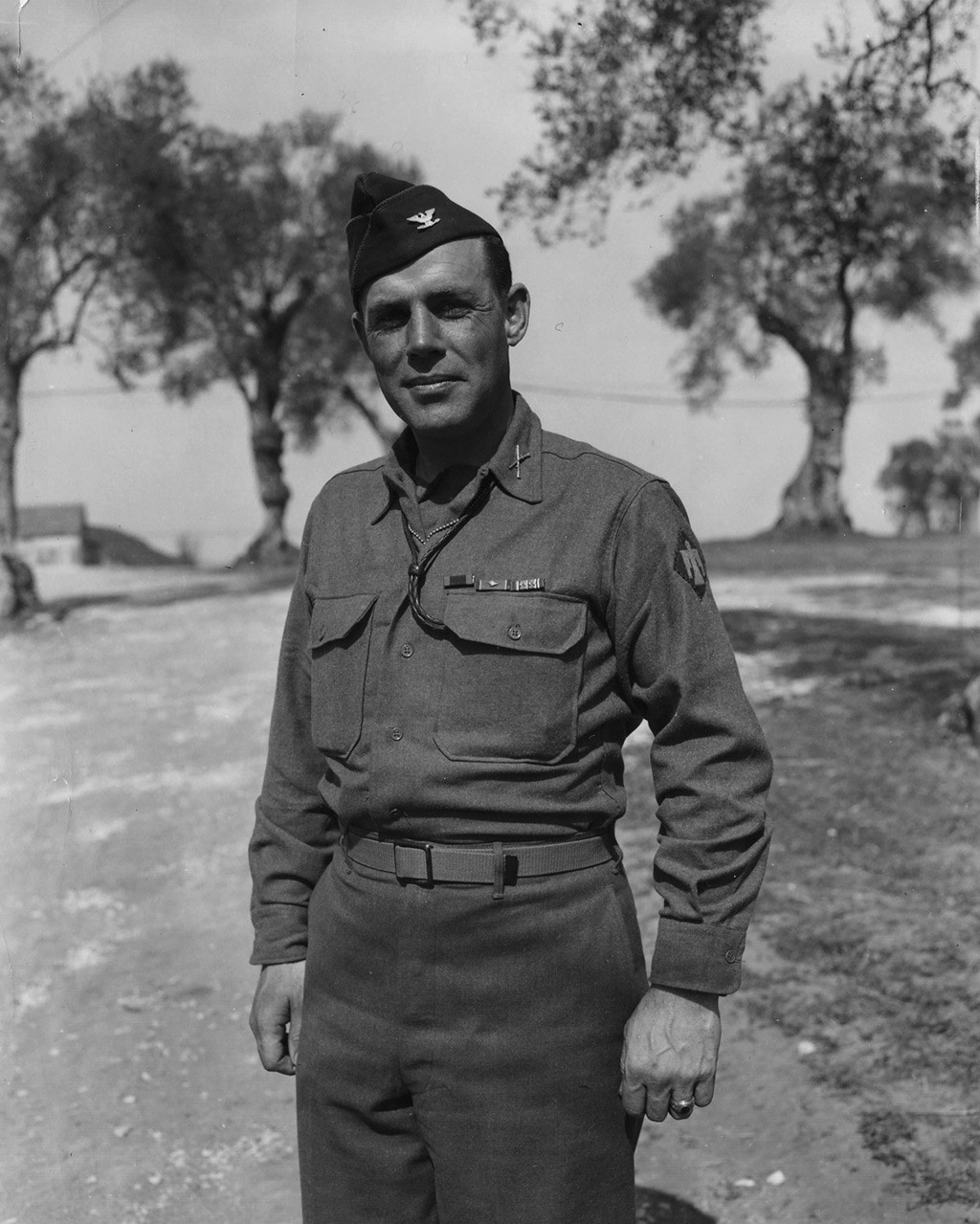
Tuesday, April 25, 1945 – At 2045 (8:45pm) the armored elements joined the waiting infantry, and the thrust toward Verona began. By 2330 (11:30pm) the regiment was in striking distance of the city. Civilians reported that there were no organized combat units in the city and that most permanent garrison personnel had been evacuated.
Wednesday, April 26, 1945 – The 1st Battalion was assigned the mission of crossing the river with tanks, tank destroyers and artillery. They were to establish a bridgehead on the opposite side, seizing the town of Bussolengo. Once over the stream, the soldiers loaded on tanks and pushed into Bussolengo. When the battalion settled down in bivouac, they did not even dig foxholes for the first time in weeks.
Thursday, April 27, 1945 –Late on the night of April 27, the regiment entrucked and moved north. By 0330 (3:30am) the 86th had contacted the 85th. Detrucking, the regiment continued the advance on foot. No trouble was encountered until 0500 when a destroyed culvert held up the march.
Friday, April 28, 1945 – By this time, the regiment had advanced well into the mountains. It was here on the shores of the beautiful Lake Garda that the Germans had elected to fight their delaying action. The road ahead led through a series of tunnels, around which elaborate defenses had been established. The tunnels were prepared for demolition and much of the road had been destroyed. It was an ideal place for the German stand. The road ran directly along the shore of the lake, and above the road soared sheer cliffs, hundreds of feet high.
Saturday, April 29, 1945 – At 0440 (4:40am) on the morning of the 29th, troopers of the 1st Battalion climbed the hills above the lake and moved north toward Nago. In order to maneuver in the rugged terrain… troops (went) back a considerable distance and then forward again over the ridges and peaks. The mountain training of the men served them in good stead. Supplies, ammunition, artillery, everything was being moved up by DUKW. German SP [self-propelled] guns in Riva kept up a constant barrage on the lake. The water was rough, and the speedboats used to evacuate the wounded had rough going. For 14 straight hours, they climbed up sheer cliffs, through ravines, and over slippery shale slopes. Finally at 1700 (5pm) they had reached a high point from which they could see Nago. The only approach to the village was through a small cut in the rocks. The Germans had a strong final protective line, a 20-mm gun, a 37-mm ack-ack gun, one tank, and self-propelled guns. Not a man in the battalion believed they could advance through that cut. When night came, though every man was so tired that he could hardly stand, the battalion moved forward. After a 15-minute artillery barrage, Company B moved through the ravine single-file. As the column wound its way over the rocks, a German plane dipped low and dropped eight personnel bombs on the weapons platoon, killing nine men… The men were beaten physically and the air bombardment was the last straw. They were then approximately 200 yards from the town. They withdrew 500 yards at 0300 (3am). They spent the rest of the cold and miserable night in the hills under constant rain of shellfire.
Sunday, April 30, 1945 – The next morning, a patrol from Company C made its way into Nago. The 1st Battalion finally occupied Nago at 1115 (11:15am) that morning. They had fought one of the most discouraging and difficult actions of the entire campaign. Rumors of peace and the end of the war were afoot, but no one took them seriously except the Italians. The 86th confidently expected to have to chase the Germans through the Brenner Pass.
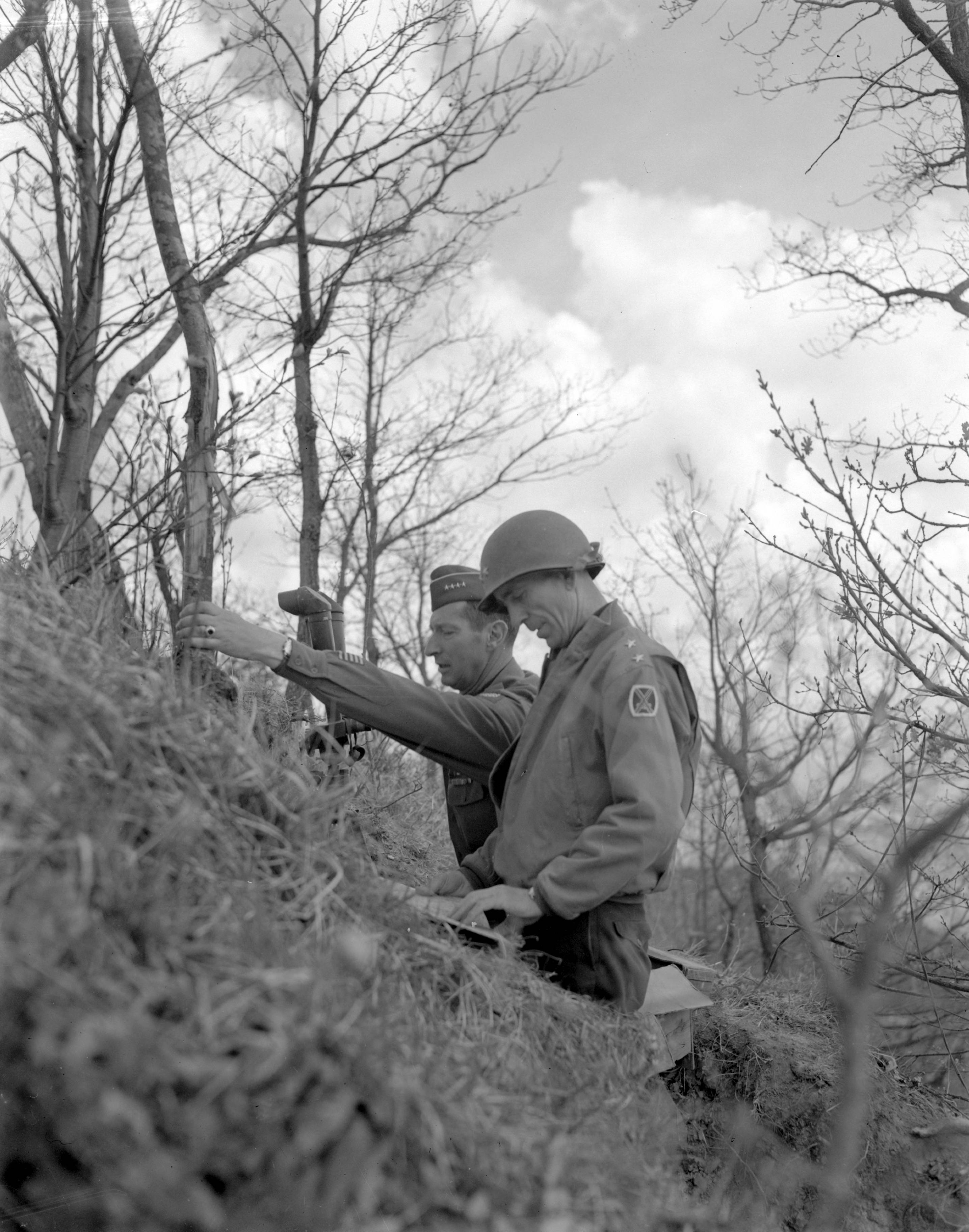
Tuesday, May 1, 1945 – General GEORGE P. HAYS… ordered the 86th to rest as much as possible during the next four days, establishing roadblocks to the north and sending out patrols to determine if the enemy had established any line of resistance to the front. Armor—tank destroyers and tanks—were brought into Riva and Torbole in expectation of coming action as fast as they could be amphibiously transported across Lake Garda. The Germans had done their usual methodical job of destruction on the bridges and tunnels around the lakeshore, and much of the road was still impassable.
Wednesday, May 2, 1945 – The war in Italy is over. The climax of the day and of the five months the 86th had spent in Italy came quickly. At 1850, (reports were that an) intercepted British broadcast had announced the unconditional surrender of the German armies in North Italy. Five minutes later, the British liaison officer from the 1125th Artillery relayed a report that the war in North Italy was over, and at 1900 (7pm) came official word… the war was “finito” and that there was to be no further firing of weapons except in defense against attack. The church bells in Riva rang wildly. Word passed quickly from official sources by word of mouth. The soldiers were, as a rule, undemonstrative. Some got wine and liquor, which the Italians brought out of hiding for the first time since the German occupation. Many bars opened and drinks were “on the house.” Partisans and a few Yanks fired their weapons into the air. Largely, the men were sober about the news. The Italians were the real revelers. They sang heartily, danced in the streets, and kissed one another happily while American soldiers looked on.
Friday, May 4, 1945 – Sunday, May 12, 1945 – A time of both war and peace. On May 4, Company C moved into Roverto. Six roadblocks were arranged for the disarming of the Partisans in that area, and the Germans were segregated under the control of their own officers. There was no trouble.
Sunday, May 13, 1945 – Monday, May 14, 1945 – The 86th moves on, moves out. …the regiment moved out of the Riva area toward the south. Their orders were to concentrate near Ghedi and Bendecino, about 40 kilometers south of Brescia. There they were to receive and guard German prisoners and await further orders. The move was complete by the night of the 14th. The entire regiment set up in tents in a bivouac in the green flat fields near an abandoned German airport. The regiment held showdown inspections and turned in its winter equipment. From a captured German warehouse, Special Service obtained and issued free to each man a bottle of fine French champagne. The men played softball and volleyball in the hot Po Valley sun. On everyone’s mind was the thought that perhaps the next stop for the regiment was a port of embarkation. I went the next night down to where the German Armies were going into the PW cage. We heard the papers say Tito wanted Trieste and they didn't want him to have it. If such were the plans, Marshal Tito of Yugoslavia disrupted them. His troops refused to evacuate the area around Trieste.
Wednesday, May 16, 1945 – The 86th gets a new mission. The regiment was alerted to move northeast to Udine, in order to keep an eye on the Yugoslavs.
Saturday, May 19, 1945 – The 86th leaves for Trieste. The 1st Battalion moved out in trucks, traveling 205 miles and stopping only for the night at Orzano. For much of the regiment, the accommodations were more luxurious than anything they had yet enjoyed in Italy, though some companies still remained in tents. The mountainous terrain reminded many of Camp Hale, and veterans of the outfit were soon skiing and mountain climbing in the surrounding peaks.
Sunday, May 20, 1945 – Saturday, June 30, 1945 – The 86th guards Trieste. Yugoslavs were garrisoned in the same areas as the Americans. Both the Slavs and the Americans carried their weapons, maintained roadblocks, and stood guard duty. But for the most part the Yugoslavs seemed friendly, and no serious incidents were reported. The Yugoslavs revealed that their instructions were to maintain the closest and most cordial relations with both Allied troops and Italian Partisans. The Americans contented themselves for the time being with close observation of the situation and the guarantee of protection and evacuation of anyone threatened with conscription by the Yugoslavs.
ARTICLES: HONOR OUR HERITAGE
 External Link Snippet REMEMBERING THOSE WHO CLIMBED BEFORE
External Link Snippet REMEMBERING THOSE WHO CLIMBED BEFORE
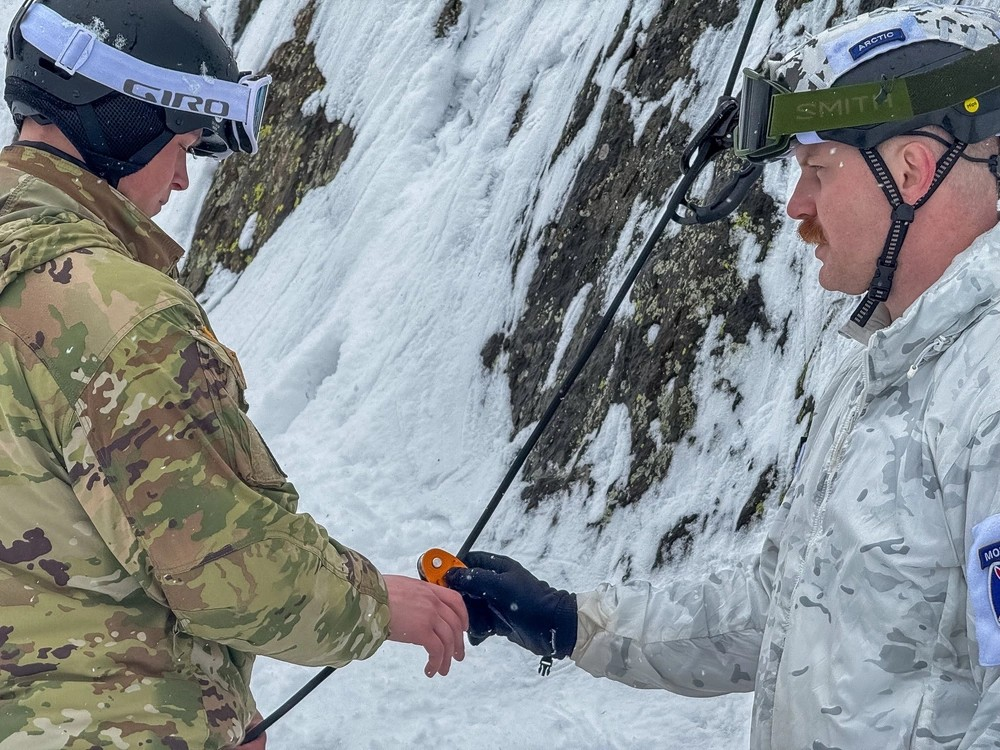 External Link Snippet WALKING THE PATH OF THOSE WHO HAVE LEFT BEHIND THEIR LEGACY
External Link Snippet WALKING THE PATH OF THOSE WHO HAVE LEFT BEHIND THEIR LEGACY
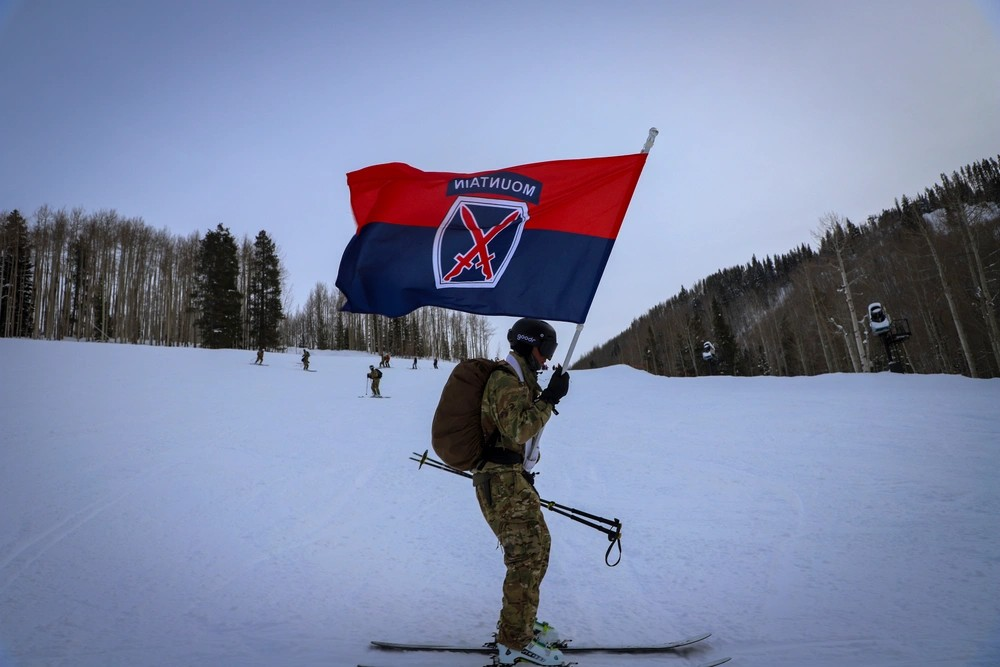 External Link Snippet LEARNING THE HISTORY AND JOINING THE LEGACY
External Link Snippet LEARNING THE HISTORY AND JOINING THE LEGACY
 External Link Snippet 10TH MOUNTAIN DIVISION SOLDIER REENLISTS ATOP RIVA RIDGE, HONORING LEGACY 80 YEARS LATER
External Link Snippet 10TH MOUNTAIN DIVISION SOLDIER REENLISTS ATOP RIVA RIDGE, HONORING LEGACY 80 YEARS LATER
 External Link Snippet WALKING IN THEIR FOOTSTEPS: SOLDIERS HONOR COL. DARBY'S LEGACY WITH 40-MILER CHALLENGE
External Link Snippet WALKING IN THEIR FOOTSTEPS: SOLDIERS HONOR COL. DARBY'S LEGACY WITH 40-MILER CHALLENGE
PHOTOS: HONOR OUR HERITAGE
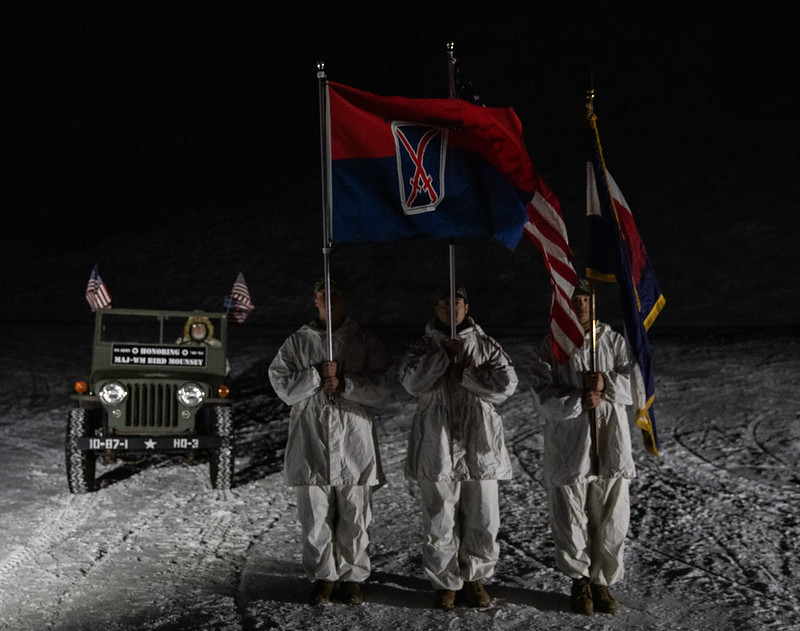
External Link Snippet =Non-Government Link
LEGACY DAYS 2025
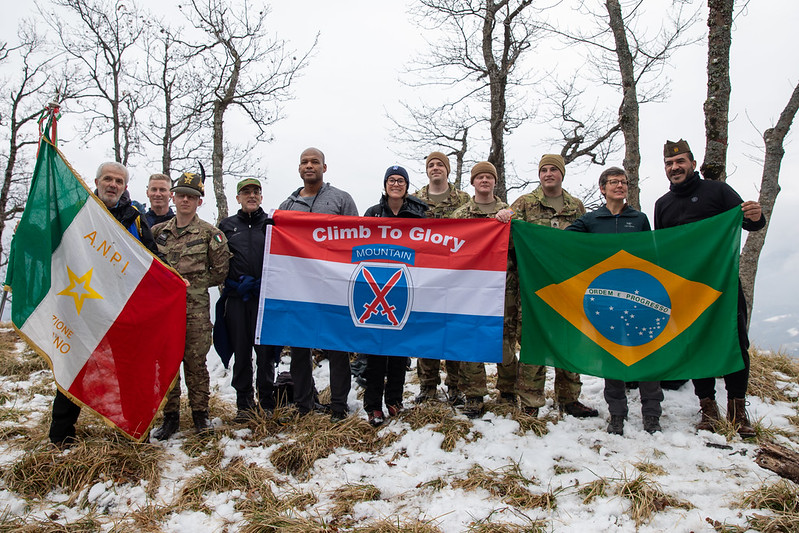 External Link Snippet =Non-Government Link
External Link Snippet =Non-Government Link
80TH ANNIVERSARY OF RIVA RIDGE DAY 1
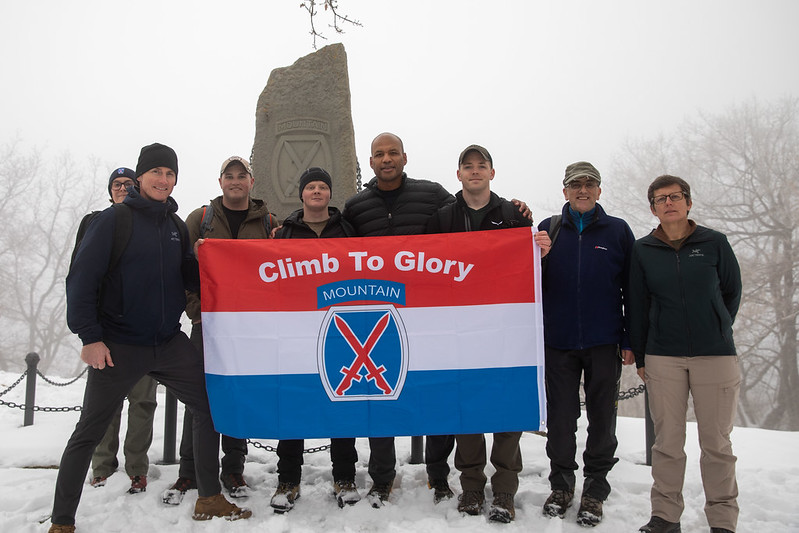 External Link Snippet = Non-Government Link
External Link Snippet = Non-Government Link
80TH ANNIVERSARY OF RIVA RIDGE DAY 2
VIDEOS: HONOR OUR HERITAGE
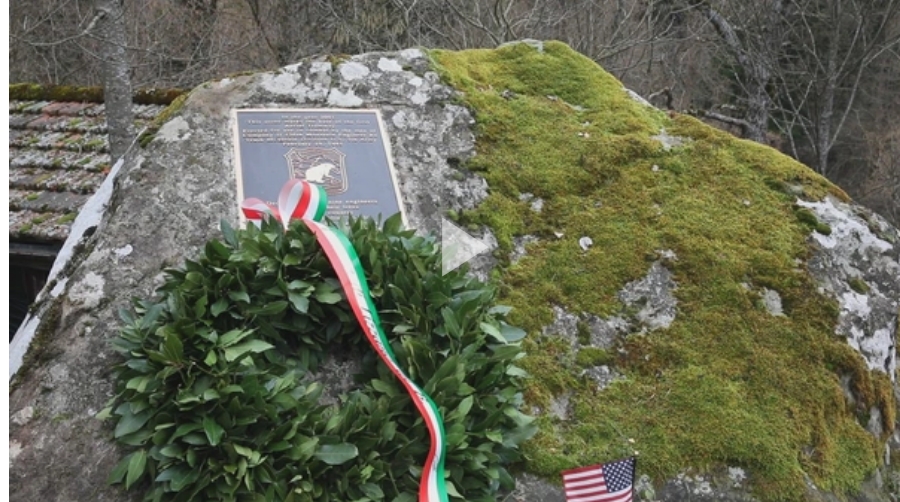 External Link Snippet 80TH ANNIVERSARY OF RIVA RIDGE
External Link Snippet 80TH ANNIVERSARY OF RIVA RIDGE
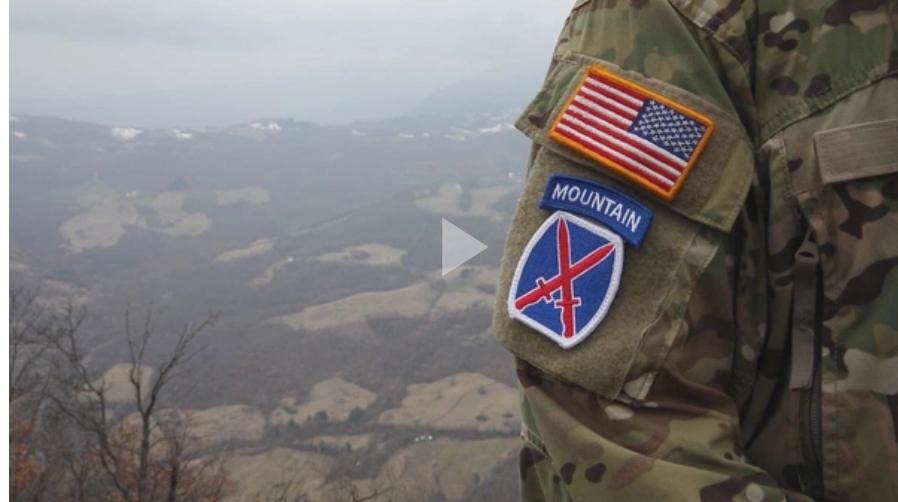 External Link Snippet RETRACING A LEGACY
External Link Snippet RETRACING A LEGACY
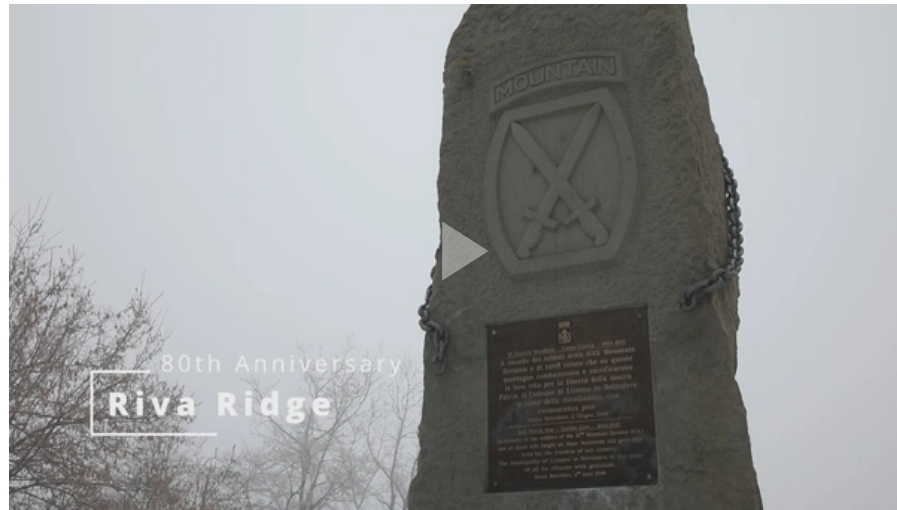 External Link Snippet 10TH MOUNTAIN DIVISION (LI) SOLDIERS HONOR THOSE WHO CLIMBED BEFORE US
External Link Snippet 10TH MOUNTAIN DIVISION (LI) SOLDIERS HONOR THOSE WHO CLIMBED BEFORE US
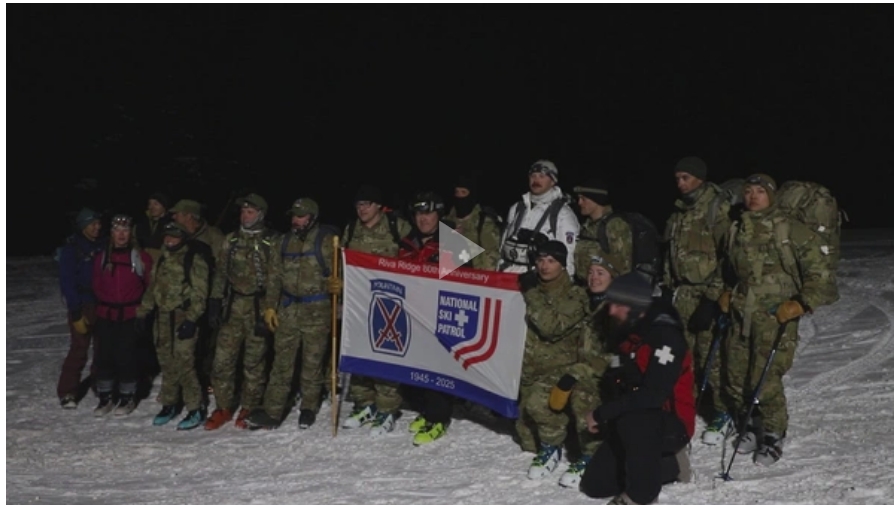 External Link Snippet 90LBS RUCKSACK CHALLENGE 2025
External Link Snippet 90LBS RUCKSACK CHALLENGE 2025
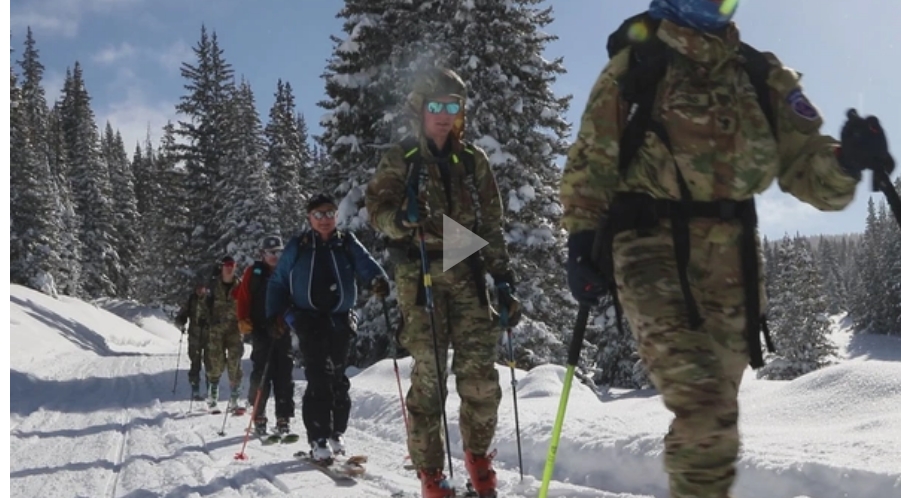 External Link Snippet 10TH MOUNTAIN DIVISION (LI) ELITE FORCES ACROSS THE HALE TO VAIL TAVERSE
External Link Snippet 10TH MOUNTAIN DIVISION (LI) ELITE FORCES ACROSS THE HALE TO VAIL TAVERSE
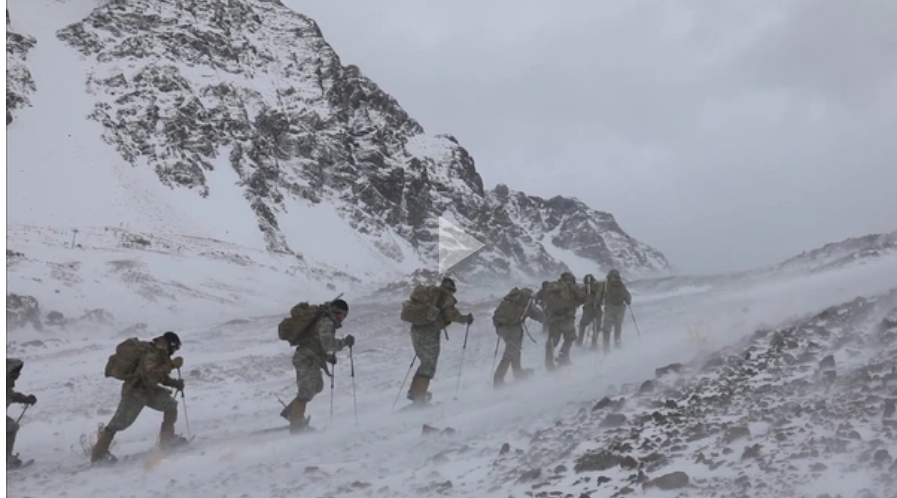 External Link Snippet 10TH MOUNTAIN DIVISION (LI): PAST AND PRESENT
External Link Snippet 10TH MOUNTAIN DIVISION (LI): PAST AND PRESENT





